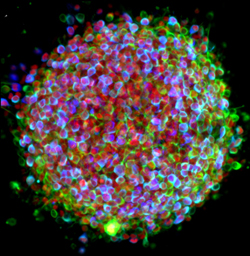Reading the headline, “Engineers Pioneer Use of 3D Printer To Create New Bones” from the BBC I can’t help but imagine your standard ink jet spitting out layers of human bone until you come up with a whole femur. In case you aren’t familiar with 3D cell printing, let me be the one to tell you that isn’t the case. I think the BBC‘s headline leaves out a crucial piece of information: what the printer in question creates is a scaffold of bone-like material.
The research in the article was conducted at Washington State University, and I find their PR headline “3D Printer Used To Make Bone-like Material” more specific. I think 3D printing, tinkering with a printer so that it can make different kinds of biomaterials, is interesting in its own right. I’m okay with the fact that the material being made is only bone-ish and not really bone. Although and argument could be made for the BBC’s headline… which I’ll explain later.
 |
| Printing the bone scaffold via WSU |
Here is the research rundown: led by Susmita Bose, professor of mechanical and materials engineering, WSU researchers used a 3D printer to to create a scaffold of calcium phosphate, silicon and zinc. When paired with actual bone, this scaffold provides a structure for new bone to grow on, to specifically manufacture the desired bone. The scaffold dissolves with no reported adverse effects, according to the researchers’ in vitro tests in rats and rabbits.
Described in the journal Dental Materials, (according to the PR*) the printer works by having the inkjet spray a plastic binder over a layer of the calcium phosphate, silicon and zinc powder in very thin layers (about 20 microns, comparable to the width of a human hair). A computer directs the printer to create the scaffold in the desired shape and size. The researchers found that after a week in a medium containing immature human bone cells, the scaffold was able to support new bone cell growth. According to the researchers, the material is likely most suitable for low load bearing (so, not a femur) and could be available for human use in a few years time.
So back to the BBC’s headline about the 3D printer creating new bone. Ultimately, that is what happens. New bone is grown around the scaffold, so the end product is real human bone. However, the printer is not itself printing bone. In my humble opinion, that doesn’t make this research any less cool. While the BBC‘s headline wasn’t itself inaccurate, I think it leaves a lot of wiggle room for assumptions (or at least imaginations like mine getting carried away with themselves) and accuracy is the end all and be all of science stories, isn’t it? Something like “3D Printer Creates Scaffold For New Bone Growth” isn’t as pretty as either headline used, but I think it would get to the heart of what this story is a little bit better.




